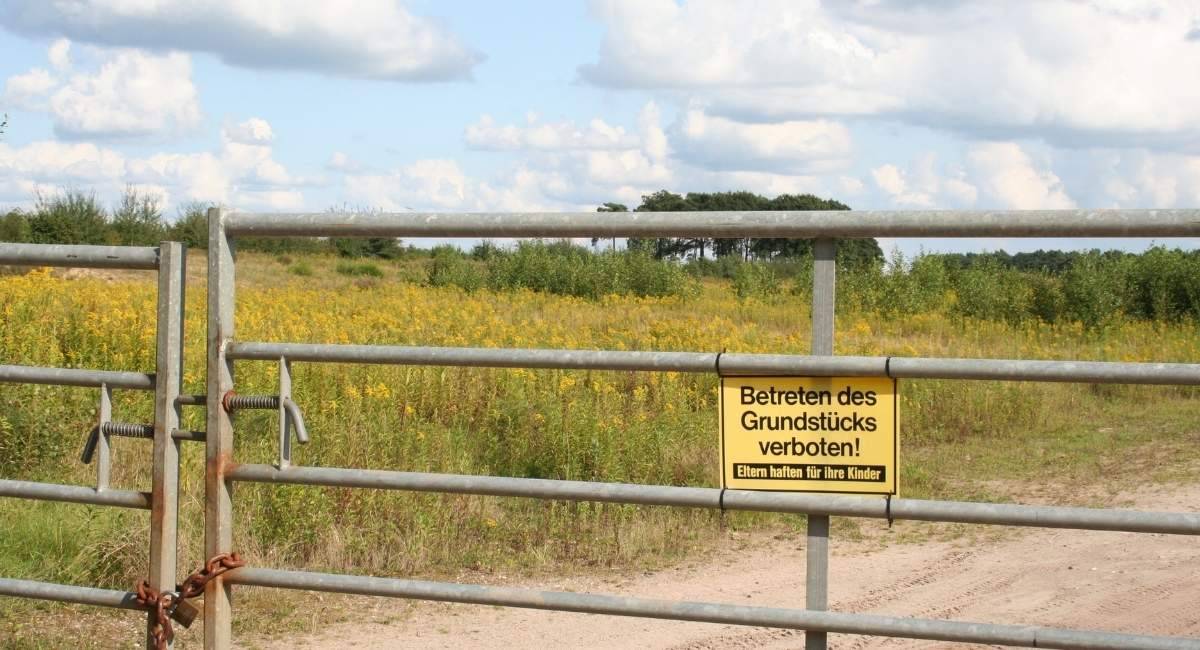Criminal trespass is a type of crime that usually involves unlawful entry on private property. In many cases, alleged offenders believed they were entitled to be on the property in question.
Criminal trespass crimes are usually classified based on the kind of property that an alleged offender entered. A number of affirmative defenses apply in these cases, so alleged offenders must be certain that they retain legal counsel.
Criminal Trespass Defense Lawyer in Plano, Allen, Frisco, and McKinney, TX
Were you or your loved one arrested for criminal trespass in the greater Plano area? Do not go to court alone.
You will want to be sure that you contact the Law Offices of Richard C. McConathy. Call (469) 304-3422 or contact us online to take advantage of a free consultation.
Criminal Trespass Charges in Plano
Under Texas Penal Code § 30.05(a), a person commits criminal trespass when they enter or remain on or in the property of another party without effective consent and the alleged offender had to notice that entry was forbidden or received notice to depart but failed to do so. Texas Penal Code § 30.05(b) defines multiple terms relating to criminal trespass, including:
- Institution of Higher Education — As defined under Education Code § 61.003, any public technical institute, public junior college, public senior college or university, medical or dental unit, public state college, or other agency of higher education as defined in this section.
- Entry — The intrusion of the entire body.
- Residential Land — Real property improved by a dwelling and zoned for or otherwise authorized for single-family or multifamily use.
- Notice — Oral or written communication by the owner or someone with apparent authority to act for the owner; fencing or other enclosure obviously designed to exclude intruders or to contain livestock; a sign or signs posted on the property or at the entrance to the building,reasonably likely to come to the attention of intruders, indicating that entry is forbidden; the placement of identifying purple paint marks on trees or posts on the property, provided that the marks are vertical lines of not less than eight inches in length and not less than one inch in width; placed so that the bottom of the mark is not less than three feet from the ground or more than five feet from the ground; and placed at locations that are readily visible to any person approaching the property and no more than 100 feet apart on forestland or 1,000 feet apart on land other than forest land; or the visible presence on the property of a crop grown for human consumption that is under cultivation, in the process of being harvested, or marketable if harvested at the time of entry.
- Recreational Vehicle Park — As defined under Water Code § 13.087, a commercial property that is designed primarily for recreational vehicle transient guest use and for which fees for site service connections for recreational vehicles, as defined by Transportation Code §522.004(b), are paid daily, weekly, or monthly.
- Shelter Center — As defined under Human Resources Code § 51.002, a program that is operated by a public or private nonprofit organization and provides comprehensive residential and non-residential services to victims of family violence.
- Recognized State — Another state with which the attorney general of this state, with the approval of the governor of this state, negotiated an agreement after determining that the other state has firearm proficiency requirements for peace officers and fully recognizes the right of peace officers commissioned in this state to carry weapons in the other state.
- Forest Land — Land on which the trees are potentially valuable for timber products.
- Protected Freshwater Area — As defined under Parks and Wildlife Code § 90.001, the portion of the bed, bottom, or bank of any navigable river or stream that lies at or below the gradient boundary of the river or stream (the term does not include that portion of a bed, bottom, or bank that lies below tidewater limits).
- Agricultural Land — As defined under Civil Practice and Remedies Code § 75.001, land that is located in this state and that is suitable for use in the production of plants and fruits grown for human or animal consumption, or plants grown for the production of fibers, floriculture, viticulture, horticulture, or planting seed; forestry and the growing of trees for the purpose of rendering those trees into lumber, fiber, or other items used for industrial, commercial, or personal consumption; or domestic or native farm or ranch animals kept for use or profit.
- Critical Infrastructure Facility — One of the following, if completely enclosed by a fence or other physical barrier that is obviously designed to exclude intruders: A chemical manufacturing facility; refinery; an electrical power generating facility, substation, switching station, electrical control center, or electrical transmission or distribution facility; a water intake structure, water treatment facility, wastewater treatment plant, or pump station; a natural gas transmission compressor station; a liquid natural gas terminal or storage facility; a telecommunications central switching office; a port, railroad switching yard, trucking terminal, or other freight transportation facility; a gas processing plant, including a plant used in the processing, treatment, or fractionation of natural gas; or a transmission facility used by a federally licensed radio or television station.
- Superfund Site — A facility that is on the National Priorities List established under Section 105 of the federal Comprehensive Environmental Response, Compensation, and Liability Act of 1980(42 U.S.C. Section 9605) or is listed on the state registry established under Health and Safety Code § 361.181.
Under Texas Penal Code § 30.05(d)(3), an alleged offense committed in a habitation or a shelter center, on a Superfund site, or on or in a critical infrastructure facility is a Class A misdemeanor. An offense committed on or in property of an institution of higher education in which the alleged offender has previously been convicted of criminal trespass relating to entering or remaining on or in property of an institution of higher education or an offense under Education Code § 51.204(b)(1) relating to trespassing on the grounds of an institution of higher education, or the alleged offender carries a deadly weapon during the commission of the offense, is also a Class A misdemeanor.
The crime of trespass by a license holder with a concealed handgun is established under Texas Penal Code § 30.06. The offense is a Class C misdemeanor if a license holder carries a concealed handgun on the property of another without effective consent and received notice that entry on the property by a license holder with a concealed handgun was forbidden.
Criminal trespass is a Class C misdemeanor under Texas Penal Code § 30.05(d)(2) when the alleged offender trespasses on agricultural land and within 100 feet of the boundary of the land, or on residential land and within 100 feet of a protected freshwater area. Any other criminal trespass offense is a Class B misdemeanor.
Criminal Trespass Penalties in Texas
Criminal trespass convictions will be punishable by the statutory maximums allowed for respective grades of misdemeanors. The possible punishments are as follows:
- Class A Misdemeanor — Up to one year in jail and/or fine of up to $4,000.
- Class B Misdemeanor — Up to 180 days in jail and/or fine of up to $2,000.
- Class C Misdemeanor — Fine of up to $500.

Criminal Trespass Defenses in Collin County
Under Texas Penal Code § 30.05(g), it is a defense to prosecution for criminal trespass that the alleged offender entered a railroad switching yard or any part of a railroad switching yard and was at that time an employee or a representative of employees exercising a right under the Railway Labor Act.
Texas Penal Code § 30.05(f) provides that it is also a defense to prosecution for criminal trespass that the basis on which entry on the property or land or in the building was forbidden is that entry with a handgun was forbidden and the person was carrying a license issued under Subchapter H, Chapter 411 of the Government Code to carry a handgun and a handgun in a concealed manner or a shoulder or belt holster.
Under Texas Penal Code § 30.05(e), it is a defense to prosecution for criminal trespass that the alleged offender at the time of the offense was a firefighter or emergency medical services personnel acting in the lawful discharge of an official duty under exigent circumstances, a person who was an employee or agent of an electric utility, a telecommunications provider, a video service provider or cable service provider, a gas utility, a pipeline used for the transportation or sale of oil, gas, or related products, or an electric cooperative or municipally owned utility, performing a duty within the scope of that employment or agency, or a person who was employed by or acting as agent for an entity that had, or that the person reasonably believed had, effective consent or authorization provided by law to enter the property, and performing a duty within the scope of that employment or agency.
If the state seeks an increase in punishment provided by Texas Penal Code § 30.05(d)(3)(B) relating to alleged offenses committed on or in property of an institution of higher education by previous offenders, Texas Penal Code § 30.05(d-2) establishes that the alleged offender can raise the issue as to whether, at the time of the instant offense or the previous offense, they were engaging in speech or expressive conduct protected by the First Amendment to the United States Constitution or Section 8, Article I of the Texas Constitution. Texas Penal Code § 30.05(h) also provides that when the state seeks the increase in punishment provided by Texas Penal Code §30.05(d)(3)(A)(iii), the alleged offender can raise the issue as to whether the alleged offender entered or remained on or in a critical infrastructure facility as part of a peaceful or lawful assembly, including an attempt to exercise rights guaranteed by state or federal labor laws. When an alleged offender proves the issue in the affirmative by a preponderance of the evidence, the increase in punishment will not apply.
Criminal Trespass Resources in Collin County
Texas Landowner Duty to Trespasser on Property – Texas A&M Agri Life — The Texas A&M Agri Life Extension Service is an education agency with a statewide network of professional educators, trained volunteers, and county offices. This article explains that the only duty that a landowner owes to a trespasser is not to intentionally injure that person or to act with “gross negligence.” Learn more about what constitutes gross negligence.
Trespassing | Texas Parks and Wildlife | Texas.gov— The Texas Parks and Wildlife Department (TPWD) has the mission “To manage and conserve the natural and cultural resources of Texas and to provide hunting, fishing and outdoor recreation opportunities for the use and enjoyment of present and future generations.” You can view answers to frequently asked questions. Also, get information about private land management.
Find A Collin County Attorney for Criminal Trespass Charges | Law Offices of Richard C. McConathy
If you or your loved one were arrested for criminal trespass in Plano or a surrounding area of Collin County, you need to keep in mind the many long-term consequences of entering a guilty plea. Get yourself a lawyer to have the best chance of achieving a more favorable outcome.
The Law Offices of Richard C. McConathy will work to make sure that you avoid the most costly consequences. We can assess all of your legal options as soon as you call (469) 304-3422 or contact us online to set up a free consultation.


